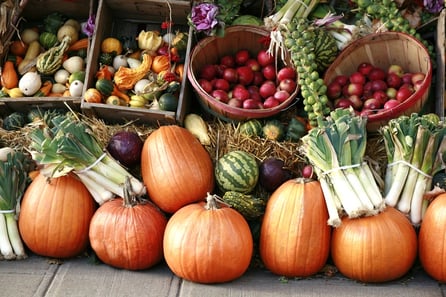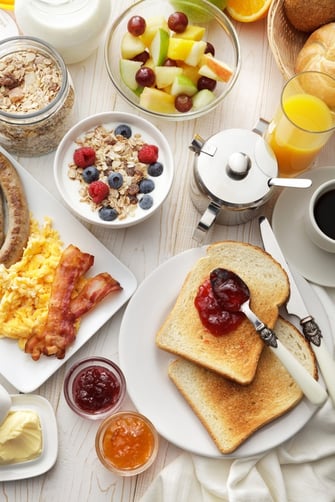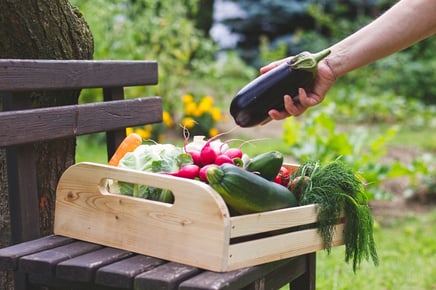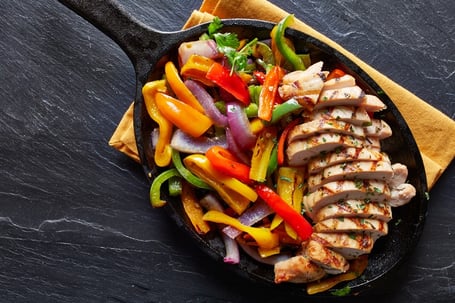 If your evening snack is turning into a fourth meal each night, that could hinder your wellness goals or sabotage your daily workout.
If your evening snack is turning into a fourth meal each night, that could hinder your wellness goals or sabotage your daily workout.
There is a lot of thinking that you shouldn’t eat after a certain time of night. However, your metabolism doesn’t shut off at a certain time, so the timing of the snack isn’t necessarily the problem, as long as you make sure to have it at least an hour before bedtime so that it can be more easily digested before you go to sleep.
More often than not, nighttime snacking is from boredom or habit rather than actual hunger. Therefore, assess how you are feeling and then decide whether you are truly hungry and need a snack to hold you over until breakfast.
Healthy Nighttime Snack Options
If you really are hungry, try some of these balanced snacks that are a better option than the salty chips or bowl of ice cream.
- One apple and a tablespoon of peanut butter
- Container of Greek yogurt with fresh fruit
- Raw veggies and hummus
- Small bowl of high-fiber cereal (at least 3 grams per serving) and milk
- String cheese or a light cheese wedge and a few whole-wheat crackers
- Air-popped popcorn and a handful of nuts
- Blueberries and strawberries with light whipped topping
- An ounce of dark chocolate and a glass of milk
- Avocado spread on a Wasa cracker or a slice of whole-wheat bread
- Low-fat cottage cheese and fruit
Are You Eating Enough During the Day?
If you are consistently starving before bed, it might mean that you aren’t eating enough calories throughout the day. Start monitoring your meals and see if you are spreading your calories evenly between breakfast, lunch, and dinner with a couple of snacks between meals. Making sure you have enough fuel throughout the day can decrease late-night desperation eating.
The other thing to consider is whether you had enough protein at dinner. Protein helps keep you full and satisfied, so have a serving around the size of the palm of your hand or around 25 grams to guarantee you are getting the benefit.
Remember to stop and assess your hunger level first before reaching for any late-night treats!
This blog was written by Angie Mitchell, RD, Wellness Coordinator. To find out more about the NIFS bloggers, click here.


 It’s Halloween time, and that can only mean one thing: sugar, lots of sugar! Toward the end of summer, stores start to taunt us by placing all of the Halloween candy out on display. What’s worst of all is that the candy is in tiny, easy-to-eat servings. By the time the actual day of Halloween rolls around, we’ve already been thumbing through fun-sized candy the entire month.
It’s Halloween time, and that can only mean one thing: sugar, lots of sugar! Toward the end of summer, stores start to taunt us by placing all of the Halloween candy out on display. What’s worst of all is that the candy is in tiny, easy-to-eat servings. By the time the actual day of Halloween rolls around, we’ve already been thumbing through fun-sized candy the entire month. Most of us are aware that the number of Americans diagnosed with diabetes is increasing, but so is the number of us at risk.
Most of us are aware that the number of Americans diagnosed with diabetes is increasing, but so is the number of us at risk.  The air is crisp, football season is in full swing, and the plentiful bounty of summer’s gardens is all gone. Instead of reverting back to the frozen fruit and veggie staples that are typical of fall and winter, experiment with some of the tasty foods that give fall the name the harvest season!
The air is crisp, football season is in full swing, and the plentiful bounty of summer’s gardens is all gone. Instead of reverting back to the frozen fruit and veggie staples that are typical of fall and winter, experiment with some of the tasty foods that give fall the name the harvest season!
 There are so many diets out there that it can be confusing as to what you should follow and who you should listen to when it comes to healthy and balanced eating. If you aren’t sure where to begin to change your current routine, take a look at these tips that Registered Dietitians (the experts in healthy habits) recommend.
There are so many diets out there that it can be confusing as to what you should follow and who you should listen to when it comes to healthy and balanced eating. If you aren’t sure where to begin to change your current routine, take a look at these tips that Registered Dietitians (the experts in healthy habits) recommend. It is important to get in the nine recommended servings of fruits and veggies each day. This can definitely be challenging. However, in the summertime when produce is readily available all over the country, this is the time to make it a priority to reach that goal! These fruits and veggies are also at their nutrient peak, which is more reason to load up and fill your plate with these colorful items!
It is important to get in the nine recommended servings of fruits and veggies each day. This can definitely be challenging. However, in the summertime when produce is readily available all over the country, this is the time to make it a priority to reach that goal! These fruits and veggies are also at their nutrient peak, which is more reason to load up and fill your plate with these colorful items! It only comes around once a year, so why not just indulge, right? Well, some of
It only comes around once a year, so why not just indulge, right? Well, some of  Here are some recipes for patriotic healthy eating. Bring one of these red, white, and blue creations to your Fourth of July
Here are some recipes for patriotic healthy eating. Bring one of these red, white, and blue creations to your Fourth of July  One of my favorite things to do once it’s summer in Indiana is visit the various farmers’ markets around town. As a dietitian, I’m a sucker for the fresh
One of my favorite things to do once it’s summer in Indiana is visit the various farmers’ markets around town. As a dietitian, I’m a sucker for the fresh  A lot of Americans see Cinco de Mayo as a reason to celebrate with all-you-can-eat chips and salsa, margaritas as big as your head, and lots of
A lot of Americans see Cinco de Mayo as a reason to celebrate with all-you-can-eat chips and salsa, margaritas as big as your head, and lots of